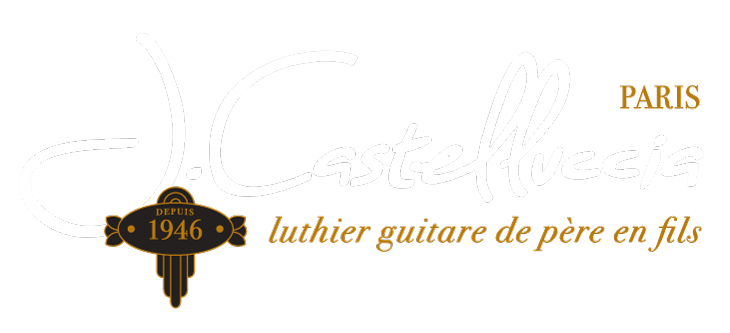Shop
Showing 26–50 of 65 results
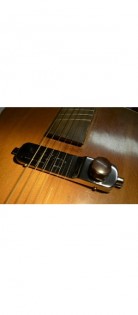
ST 48 « Yves Guen original »
267€ outside EU (excl. 20% VAT)
This microphone was designed in 1948, Django Reinhardt has worked on its design.
Some improvements have been made to the sound balance of the strings and magnetic clip attachment system.
Interview of Christian Gwen by Clément Reboul
[badge bgcolor="#982b31" value="Available on order"]
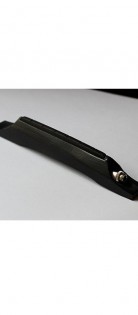
Castelluccia Piezzo Bridge Pickup
308,33€ outside EU (excl. 20% VAT)
Intégré au chevalet et logé sous le sillet amovible en ébène, spécificité propre à la maison Castelluccia depuis 1946, le piezzo équipant ce chevalet en ébène dispose d'une impédance optimale qui vous permettra d'obtenir un rendu sonore amplifié optimisé et non dénaturé. Disponible sur commande et fabriqué sur mesure en fonction des côtes du chevalet original.
[badge bgcolor="#982b31" value="Available on order"]
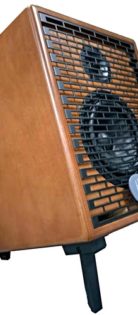
Prodipe Natural 6 Cherrywood
541€ outside EU (excl. 20% VAT)
L'enceinte électro-acoustique active Prodipe Natural 6 Cherrywood est le fruit d'un long travail de recherche et de conception, mené en collaboration avec Ludovic LANEN, sur la sonorité afin de respecter la couleur et le caractère de l’instrument acoustique même lorsqu’il est amplifié.
Destiné à tous les guitaristes et plus largement à tous les instrumentistes acoustiques, facile et léger à transporter, le Natural 6 Cherrywood sera à ne pas en douter un outil indispensable.
- Imaginez une guitare qui sonnerait sur votre ampli, de la même façon qu'au naturel. Grâce à l’expérience de PRODIPE dans les enceintes de monitoring où la recherche du son le plus neutre possible est l’alpha et l’omega, le Natural 6 Cherrywood réussit cet exploit. Il est équipé d’une bi-amplification de 140 Watts RMS accompagnée par un tweeter dôme à système magnétique néodymium et un woofer 6 pouces en fibre de verre.
- Le Natural 6 Cherrywood dispose d’une table de mixage intégrée très complète avec plusieurs entrées et sorties symétriques, un équaliseur 3 bandes par ligne, une alimentation fantôme, une réverbe DSP numérique 8 programmes, un anti feed back et un ground lift, afin de connecter l’ensemble des instruments acoustiques, vos micros dynamiques ou statiques ou encore une source stéréo en entrée et en sortie.
- Pratique, polyvalent et robuste. De forme cubique et équipé d’une poignée de transport, le Natural 6 est très pratique à transporter. Il est également équipé de deux pieds repliables qui permettent de le mettre en position retour ainsi qu’une embase pour pied d’enceinte qui en font un outil de travail professionnel et très polyvalent.
- Grâce à sa finition en contreplaqué, cet ampli acoustique est plus léger que le Natural 6 Black et très résistant aux chocs.
. [badge bgcolor="#982b31" value="Available on order"]
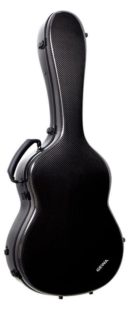
Gewa 100% Carbon Classical guitar case
795€ outside EU (excl. 20% VAT)
La marque GEWA propose un étui 100% carbone pour guitare classique. Les avantages que confèrent ce genre de matériau dans la confection des étuis sont multiples. La solidité tout d'abord. C'est un point essentiel pour les guitaristes jouant sur des instruments d'exception ou voyageant souvent avec leur guitare et surtout l'extrême légèreté.
[badge bgcolor="#982b31" value="Available on order"]
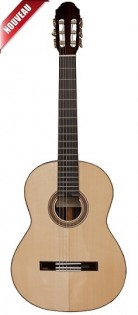
E series – JEREZ
825€ outside EU (excl. 20% VAT)
Fabriquée entièrement à la main sous la direction technique de J. Castelluccia. [badge bgcolor="#982b31" value="Available on order (2-3 months)"]
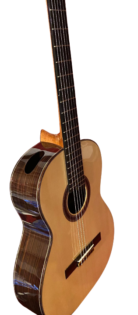
STudio +
Always keen to offer the best to our guitarist friends, here's a new model of classical guitars designed to meet their expectations. With a highly adjusted price range, these guitars boast exceptional acoustic qualities in terms of bass/midrange/treble balance and polyphonic clarity, with an elegant, refined timbre that sets notes apart.
This is the Castelluccia signature sound found on all the other models in the top range.
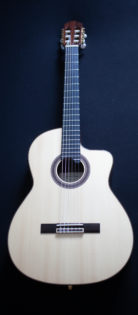
Crossover CRW12 LATTICE
1217€ outside EU (excl. 20% VAT)
This crossover version is a hybrid nylon string guitar.
It has the characteristics of a traditional classical guitar, but with specific features that evoke the electric or even folk worlds (the neck is narrower at the nut and the body is more compact).
Its rich and warm acoustic properties, combined with its great polyphonic clarity, allow a dynamic musical play, all in nuances.
This J. Castelluccia guitar, electro-acoustic, offers the possibility to play in various styles, to approach the classical register, jazz, bossa nova and many others...
The principle of the lattice bracing was invented in the early 80's by the Australian luthier Greg Smallman. His goal was to make the soundboard as thin as possible, to make it vibrate more freely.
At the time, traditional bracing could not support such a thin top, so Smallman decided to develop a new bracing system, made of wood reinforced with carbon rods.
Because the vibrations of the top are lost in the sides and back of the guitar, he decided to make these two components heavier, so that they are almost inert. By doing so, the soundboard reacts like a drumhead and projects a powerful sound.
However, this concept, which favors projection and power, has materialized at the expense of the instrument's main characteristics, such as sound identity, balance and musicality. In the end, the need to add modifications was inevitable.
As I regularly address a clientele whose leitmotiv is to play the guitar to make music (and not the opposite), I decided to use this lattice bracing principle anyway. And to make it evolve, in order to bring all the technical characteristics, which must imperatively have a guitar of reputation.
From this will was born the CRW12, equipped with a specific lattice system, combined with specially studied components, so that the lacks of the Australian prototype are corrected.
The CRW12 Lattice is the result of further research, allowing the benefits of the lattice system in terms of power and projection, while preserving the DNA of the traditional classical guitar: its quality of tone, balance and musicality.
The Fishman Pro Blend system integrates two types of sources: a piezo sensor under the saddle and an overhead pickup positioned in the body, producing a very wide range of sounds.
[button style="btn-default btn-sm" type="link" target="true" title="Voir le banc d'essai" link=" http://www.guitaremag.com/article/guitares-j-castellucia/"]
[badge bgcolor="#982b31" value="AVAILABLE"]
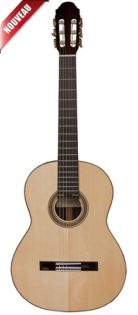
Lutèce
1241,67€ outside EU (excl. 20% VAT)
[badge bgcolor="#982b31" value="Nouveauté"]
After extensive research, here is an exceptional new model, the”Lutèce”. With exquisite solid Indian rosewood back and sides and A LATTICE bracing, this guitar has increased power and greater response combined with remarkable balance and clarity. At the same time it preserves the richness and beauty of a traditional tone.
[badge bgcolor="#982b31" value="Disponible"]
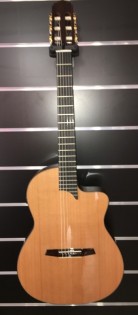
Crossover CRW14 LATTICE
1300€ outside EU (excl. 20% VAT)
For the steel string player who wants to play on a nylon string guitar but with the sensation of a steel string guitar.
Cette version Crossover 14 cases hors caisse est une guitares à cordes nylon hybride qui dispose des caractéristiques d'une classique traditionnelle, agrémentées de spécificités évoquant les univers électriques ou folks (manche moins large au sillet de tête , caisse plus compacte...).
Elle offre des caractéristiques acoustiques riches et chaleureuses ainsi qu'une grande clarté polyphonique et permet un jeu en nuance et dynamique. C'est une guitare éclectique au niveau des styles, permettant d'aborder le registre classique, mais également et entre autre le jazz, la bossa nova etc...
Ce modèle dispose d'un barrage système Lattice issu du modèle classique 70th.
Le principe du barrage lattice a été inventé par le luthier australien Greg Smallman, son objectif était à l'époque de rendre la table d’harmonie la plus fine possible, de manière à la faire vibrer le plus librement possible. Les barrages dits traditionnels ne pouvant supporter une table aussi fine, ce luthier a décidé de mettre au point un nouveau système de barrage en croisillon constitué de bois renforcé avec des tiges de carbone. Persuadé du fait que les vibrations de la table se perdent dans les éclisses et le fond de la guitare, Il décide également d’alourdir ces 2 composantes, de manière à les rendre quasiment inertes. Avec ce concept, il arrive à faire réagir la table d’harmonie comme une peau de tambour avec un résultat qui se concrétise par une grande projection et puissance de son.
Cependant force est de constater que ce concept qui favorise la puissance et la projection au détriment des autres éléments primordiaux constituant les caractères principaux de l'instrument comme par exemple le timbre, l’équilibre et la musicalité, produit au final une guitare au timbre dénaturé, au son très linéaire permettant difficilement un jeu en nuance.
M’adressant exclusivement à une clientèle dont le leitmotiv est de jouer de la guitare pour faire de la musique et pas l’inverse, j’ai décidé malgré tout d’utiliser ce principe de barrage lattice et de le le faire évoluer afin de retrouver toutes les caractéristiques techniques dont doit impérativement disposer une guitare digne de ce nom. De cette volonté est née la CRW14 équipée d’un système Lattice spécifique combiné à des composantes spécialement étudiées, de manière à corriger les manques de la lattice australienne.
La CRW14 Lattice est donc le fruit d’une recherche accrue permettant de bénéficier des atouts que procure le système lattice en terme de puissance et projection, tout en préservant l’ADN de la guitare classique traditionnelle en terme de qualité de timbre, d’équilibre et de musicalité.
Le système Fishman Pro Blend permet de combiner 2 types de sources : un capteur piezzo sous sillet et un micro aérien positionné dans la caisse, offrant une palette de son très large.
[button style="btn-default btn-sm" type="link" target="true" title="Voir le banc d'essai" link=" http://www.guitaremag.com/article/guitares-j-castellucia/"]
[badge bgcolor="#982b31" value="DISPONIBLE SOUS 2 à 3 MOIS"]
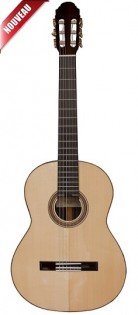
70th Lattice PSI
Offre Spéciale Anniversaire
1667€ outside EU (excl. 20% VAT)
[badge bgcolor="#982b31" value="Nouveauté"]
After extensive research, here is an exceptional new model, the”70th”. With exquisite solid Madagascar rosewood back and sides and A LATTICE bracing, this guitar has increased power and greater response combined with remarkable balance and clarity. At the same time it preserves the richness and beauty of a traditional tone.
[badge bgcolor="#982b31" value="Disponible"]
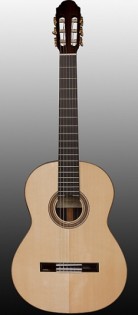
Arpeggio
1667€ outside EU (excl. 20% VAT)
[button style="btn-default btn-sm" type="link" target="true" title="Voir le banc d'essai" link="/wp-content/uploads/2015/03/G6.pdf"]
Highest quality Alpine Spruce or Western Red Cedar soundboard.
First grade Indian rosewood back and sides. Ebony fingerboard with nickel alloy frets.
650 mm scale with 52 mm bone nut. cedar neck reinforced with ebony center strip.
The power and open, clear tone of this model will amaze you.
[badge bgcolor="#982b31" value="Available on order between 2 and 4 months"]
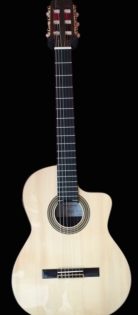
Crossover CRW12 LATTICE De Luxe
This crossover version is a hybrid nylon string guitar.
It has the characteristics of a traditional classical guitar, but with specific features that evoke the electric or even folk worlds (the neck is narrower at the nut and the body is more compact).
Its rich and warm acoustic properties, combined with its great polyphonic clarity, allow a dynamic musical play, all in nuances.
This J. Castelluccia guitar, electro-acoustic, offers the possibility to play in various styles, to approach the classical register, jazz, bossa nova and many others...
The principle of the lattice bracing was invented in the early 80's by the Australian luthier Greg Smallman. His goal was to make the soundboard as thin as possible, to make it vibrate more freely.
At the time, traditional bracing could not support such a thin top, so Smallman decided to develop a new bracing system, made of wood reinforced with carbon rods.
Because the vibrations of the top are lost in the sides and back of the guitar, he decided to make these two components heavier, so that they are almost inert. By doing so, the soundboard reacts like a drumhead and projects a powerful sound.
However, this concept, which favors projection and power, has materialized at the expense of the instrument's main characteristics, such as sound identity, balance and musicality. In the end, the need to add modifications was inevitable.
As I regularly address a clientele whose leitmotiv is to play the guitar to make music (and not the opposite), I decided to use this lattice bracing principle anyway. And to make it evolve, in order to bring all the technical characteristics, which must imperatively have a guitar of reputation.
From this will was born the CRW12, equipped with a specific lattice system, combined with specially studied components, so that the lacks of the Australian prototype are corrected.
The CRW12 Lattice is the result of further research, allowing the benefits of the lattice system in terms of power and projection, while preserving the DNA of the traditional classical guitar: its quality of tone, balance and musicality.
The Fishman Pro Blend system integrates two types of sources: a piezo sensor under the saddle and an overhead pickup positioned in the body, producing a very wide range of sounds.
[button style="btn-default btn-sm" type="link" target="true" title="Voir le banc d'essai" link=" http://www.guitaremag.com/article/guitares-j-castellucia/"]
[kad_youtube url="https://youtu.be/5ASCNH4yekY" ]
[badge bgcolor="#982b31" value="AVAILABLE WITHIN 3 TO 4 MONTHS"]
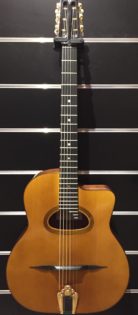
Gypsy
1908 € outside EU (excl. 20% VAT)
Even with the history of J.Castelluccia’s workshop, currently representing with its 70 years of existence the oldest lutherie specializing in the manufacturing of gypsy jazz guitars, we continue to make it a point of honor to provide our customers handcrafted products with the best quality for the price as is possible.
Following tradition, the acoustic qualities and finishes of the Gypsy make it an ideal guitar to begin playing in Manouche style. Presented by Acoustic Guitarist magazine as a guitar with unmatched quality for its price, this instrument is designed after an original Selmer. It has bracing made of four crossbars, as have J.Castelluccia models of the 50s and the famous Selmer #503 which belonged to Django Reinhardt and currently visible at the Museum of La Villette in France.
The Gypsy, offered at 1990 € TTC, made entirely by hand and in the tradition of the art - creased soundboard (pliage), selected wood quality tuners and tailpiece, etc. - can claim to be, to this day, the least expensive handmade guitars in this style in the world!
The Gypsy features a high grade European spruce top, Palo Leo rosewood back and sides, and a walnut neck. This instrument is fitted with a set of high quality three-on-a plate-tuners and Castelluccia’s own JC tailpiece. The high grade woods and hardware found on this instrument are rarely found on French made guitars under 2500€, making this instrument an exceptional deal for someone looking for luxurious features at an affordable price. Notable design features include gently rounded binding which adds additional comfort by not pressing into your body like more conventional binding does. Additionally, the bridge includes a replaceable ebony saddle, a feature rarely found on Selmer style bridges which are normally fashioned from one piece of solid wood. You can easily adjust the action by simply swapping out the saddle piece for one of a different height.
[button style="btn-default btn-sm" type="link" target="true" title="Voir le banc d'essai" link="/wp-content/uploads/2015/03/gypsy.pdf"]
[badge bgcolor="#982b31" value="Available on order 4 months"]
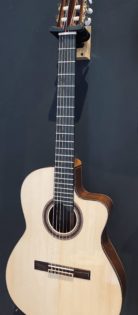
CRW 14-R De Luxe
This 14-fret Crossover version is a hybrid nylon-string guitar with all the characteristics of a traditional classical guitar, enhanced by specific features reminiscent of the electric or folk worlds (narrower neck at the nut, more compact body, etc.).
It offers rich, warm acoustic characteristics, polyphonic clarity and nuanced, dynamic playing. It's an eclectic guitar in terms of styles, allowing you to tackle the classical register, as well as jazz, bossa nova and more...
This model features a Lattice bracing system derived from the classic 70th model.
The lattice dam principle was invented by Australian luthier Greg Smallman, whose aim at the time was to make the soundboard as thin as possible, so that it would vibrate as freely as possible. Since traditional bracing could not support such a thin top, the luthier decided to develop a new bracing system made of wood reinforced with carbon rods. Convinced that vibrations from the top are lost in the guitar's sides and back, he also decided to make these 2 components heavier, so as to render them virtually inert. With this concept, he succeeded in making the soundboard react like a drumhead, with the result of great projection and power of sound.
However, it has to be said that this concept, which favors power and projection to the detriment of the other primordial elements that make up the instrument's main characteristics, such as timbre, balance and musicality, ultimately produces a guitar with a distorted timbre and a very linear sound that makes it difficult to play with nuance.
Aiming exclusively at a clientele whose motto is to play guitar to make music, and not the other way around, I decided to use the lattice bracing principle and develop it further, in order to provide all the technical features that a guitar worthy of the name must have. The result is the CRW14, equipped with a specific Lattice system combined with specially designed components to correct the shortcomings of the Australian Lattice.
The CRW14-R Lattice is therefore the fruit of extensive research, enabling us to benefit from the advantages of the lattice system in terms of power and projection, while preserving the DNA of the traditional classical guitar in terms of tone quality, balance and musicality.
The Fishman Pro Blend system combines 2 types of sources: a piezo sensor under the saddle and an air pickup positioned in the body, offering a very broad palette of sound.
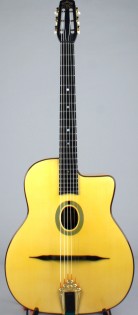
Tears
1992€ outside EU (excl. 20% VAT)
Cette guitare a été fabriquée à partir d'une Selmer originale. [badge bgcolor="#982b31" value="Available on order (3-4 months)"]
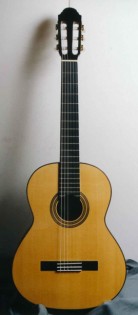
FG2
2000€ outside EU (excl. 20% VAT)
Fabriquée entièrement à la main sous la direction technique de J. Castelluccia. [badge bgcolor="#982b31" value="Available on order (2-3 months)"]
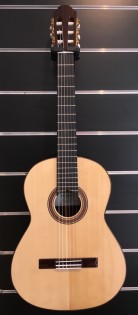
Récital (ex:60th Anniversary)
This guitar delivers a full rich tone, warmer than the general run of spruce top instruments with excellent sustain and projection. The clear definition of notes allows for expressive interpretation of contrapuntal music and the great dynamic range embellishes romantic works.
A fine guitar for an aspiring concert artist.
[button style="btn-default btn-sm" type="link" target="true" title="Voir le banc d'essai" link="/wp-content/uploads/2015/03/60th-classic.pdf"]
[badge bgcolor="#982b31" value="Available"]
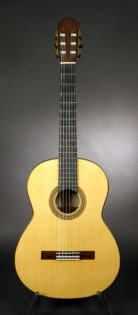
Negra
2000€ outside EU (excl. 20% VAT)
This type of flamenco guitar, made popular by the famous guitarist Paco de Lucía, has a rosewood body that is less dry and percussive than a "blanca" cypress guitar. It has a crispy sound (in rasgueados), a longer sustain and a richness of harmonics.
[badge bgcolor="#982b31" value="Disponible sur commande - Délai 2 à 3 mois"]
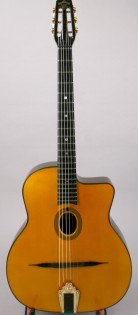
Menilmontant
2075€ outside EU (excl. 20% VAT)
This model presents the particularity to have a bracing inspired by the Selmer N°503, a bracing composed of four braces instead of five as on all the other Selmer's.
For the little story, this mythical Selmer 503 having belonged to Django and used in a quasi exclusive way by this last one from 1940 to his death is currently exposed to the Museum of the Music in Paris.
[badge bgcolor="#982b31" value="Available"]

Oldschool 48
2242€ outside EU (excl. 20% VAT)
Reissue of the legendary jazz guitar Selmer style made by my grandfather in the 40s and 50s, and also popularized in the early 2000s by the prestigious guitarist Dorado Schmitt (Vienna festival with Bireli Lagrene). It has the particularity to have an arched back (curved molded) without back braces offering to the guitar a big sound projection and characteristic tone of the time, the famous “Oldschool sound”. With his intermediate D hole format, designed by my grandfather and become one of the distinguishing features of the brand, it offers maximum versatility in terms of playability. The mold used was the one used by my grandfather in time and materials including mahogany and cedar top from a very old stock from the years 40, that belonged therefore to my grandfather and then my father. According to the original, its neck is mahogany integrating a trussrod intended to optimize playing comfort, and has a vintage patina type finish. This guitar received glorious reviews in Guitarist Acoustic magazine.
LE TEMOIGNAGE DE DORADO SCHMITT J'ai joué pendant plus de 10 ans, un peu partout dans le monde, avec cette guitare là. Je l'avais trouvée à Bruxelles, sur un marché aux puces, dans les années 90. J'ai juste fait refretter la touche et poser un trussrod, si jamais le manche bougeait, sinon je l'ai laissée dans son "jus". Au niveau du son, c'est une guitare exceptionnelle. Pour moi, c'est vraiment le grain, le son "Django", avec de très bonnes basses et aussi beaucoup d'aigus. Il faut dire que la rosace en D, chez Castelluccia, est plus petite que chez Maccaferri. C'est ça aussi qui donne ce son. Parce que les guitares "en D" sonnent souvent un peu "creux". Là, pas du tout ! castelluccia avait un secret bien à lui. A Vienne, tout le monde l'a essayée i Bireli, Stochello, Angelo Debarre, Sylvain Luc, qui l'a trouvait exceptionnelle... Malheureusement, je m'en suis séparé lors d'une soirée un peu "arrosée". Quelqu'un qui connaissait ce modèle a voulu absolument me l'acheter. Le lendemain, j'ai regretté! J'e rêve encore ... Chaque guitariste a son son, mais c'est franchement une super guitare !" [button style="btn-default btn-sm" type="link" target="true" title="Voir le banc d'essai" link="/wp-content/uploads/2015/03/Oldschool-48.pdf"] [badge bgcolor="#982b31" value="Disponible sur commande sous 3 à 4 mois"]
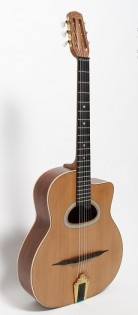
Oldschool 48
2242€ outside EU (excl. 20% VAT)
Reissue of the legendary jazz guitar Selmer style made by my grandfather in the 40s and 50s, and also popularized in the early 2000s by the prestigious guitarist Dorado Schmitt (Vienna festival with Bireli Lagrene). It has the particularity to have an arched back (curved molded) without back braces offering to the guitar a big sound projection and characteristic tone of the time, the famous “Oldschool sound”. With his intermediate D hole format, designed by my grandfather and become one of the distinguishing features of the brand, it offers maximum versatility in terms of playability. The mold used was the one used by my grandfather in time and materials including mahogany and cedar top from a very old stock from the years 40, that belonged therefore to my grandfather and then my father. According to the original, its neck is mahogany integrating a trussrod intended to optimize playing comfort, and has a vintage patina type finish.
This guitar received glorious reviews in Guitarist Acoustic magazine.
LE TEMOIGNAGE DE DORADO SCHMITT J'ai joué pendant plus de 10 ans, un peu partout dans le monde, avec cette guitare là. Je l'avais trouvée à Bruxelles, sur un marché aux puces, dans les années 90. J'ai juste fait refretter la touche et poser un trussrod, si jamais le manche bougeait, sinon je l'ai laissée dans son "jus". Au niveau du son, c'est une guitare exceptionnelle. Pour moi, c'est vraiment le grain, le son "Django", avec de très bonnes basses et aussi beaucoup d'aigus. Il faut dire que la rosace en D, chez Castelluccia, est plus petite que chez Maccaferri. C'est ça aussi qui donne ce son. Parce que les guitares "en D" sonnent souvent un peu "creux". Là, pas du tout ! castelluccia avait un secret bien à lui. A Vienne, tout le monde l'a essayée i Bireli, Stochello, Angelo Debarre, Sylvain Luc, qui l'a trouvait exceptionnelle... Malheureusement, je m'en suis séparé lors d'une soirée un peu "arrosée". Quelqu'un qui connaissait ce modèle a voulu absolument me l'acheter. Le lendemain, j'ai regretté! J'e rêve encore ... Chaque guitariste a son son, mais c'est franchement une super guitare !"
[button style="btn-default btn-sm" type="link" target="true" title="Voir le banc d'essai" link="/wp-content/uploads/2015/03/Oldschool-48.pdf"]
Filippo Dall'Asta
[badge bgcolor="#982b31" value="Disponible sur commande sous 4 à 5 mois"]
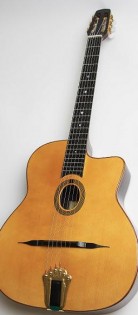
Nuages
2242€ outside EU (excl. 20% VAT)
The Nuages is an exact replica of the Selmer guitar in terms of technical characteristics.
In keeping with the original, it boasts the same acoustic qualities in terms of tone, balance and power.
The back and sides are made of Pau Ferro, a dense Brazilian wood, for optimum sound definition and "pearl" high notes.
Equipped with a removable ebony saddle bridge, a Castelluccia hallmark since 1946, making it easy to adjust the action.
This guitar is based on an original Selmer.
[badge bgcolor="#982b31" value="Available on order (3-4 months)"]
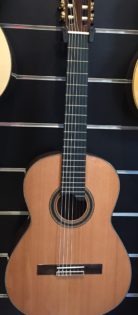
70th – 7 Strings Lattice New
2250€ outside EU (excl. 20% VAT)
[badge bgcolor="#982b31" value="Nouveauté"]
After extensive research, here is an exceptional new model, the”70th”. With exquisite solid Madagascar rosewood back and sides and A LATTICE bracing, this guitar has increased power and greater response combined with remarkable balance and clarity. At the same time it preserves the richness and beauty of a traditional tone.
Le principe du barrage lattice a été inventé par le luthier australien Greg Smallman, son objectif était à l'époque de rendre la table d’harmonie la plus fine possible, de manière à la faire vibrer le plus librement possible. Les barrages dits traditionnels ne pouvant supporter une table aussi fine, ce luthier a décidé de mettre au point un nouveau système de barrage en croisillon constitué de bois renforcé avec des tiges de carbone. Persuadé du fait que les vibrations de la table se perdent dans les éclisses et le fond de la guitare, Il décide également d’alourdir ces 2 composantes, de manière à les rendre quasiment inertes. Avec ce concept, il arrive à faire réagir la table d’harmonie comme une peau de tambour avec un résultat qui se concrétise par une grande projection et puissance de son. Cependant force est de constater que ce concept qui favorise la puissance et la projection au détriment des autres éléments primordiaux constituant les caractères principaux de l'instrument comme par exemple le timbre, l’équilibre et la musicalité, produit au final une guitare au timbre dénaturé, au son très linéaire permettant difficilement un jeu en nuance. M’adressant exclusivement à une clientèle dont le leitmotiv est de jouer de la guitare pour faire de la musique et pas l’inverse, j’ai décidé malgré tout d’utiliser ce principe de barrage lattice et de le le faire évoluer afin de retrouver toutes les caractéristiques techniques dont doit impérativement disposer une guitare digne de ce nom. De cette volonté est née la 70th équipée d’un système Lattice spécifique combiné à des composantes spécialement étudiées, de manière à corriger les manques de la lattice australienne. La 70th à 7 cordes est donc le fruit d’une recherche accrue permettant de bénéficier des atouts que procure le système lattice en terme de puissance et projection, tout en préservant l’ADN de la guitare classique traditionnelle en terme de qualité de timbre, d’équilibre et de musicalité. Le témoignage d'un guitariste professionnel, Yann Raix : Récemment, le luthier Jean-Baptiste Castelluccia m'a proposé d'essayer sa guitare avec un montage « lattice ». N'étant pas particulièrement « fou fou » de ce genre de montage, il était intéressant de voir cette réalisation faite par un luthier dans la grande tradition. La guitare présente une très belle finition avec un magnifique palissandre de Madagascar et une belle table en épicéa. On ne se refait pas : même à travers le montage « lattice » on reconnaît la « patte » de ce luthier : très beau timbre dans les aigus dynamiques avec une chanterelle très chantante ; bref, la musicalité et la finesse sont au rendez-vous. Les qualités du montage « lattice » sont bien là aussi : ampleur, puissance et projection. Au fait, le prix : 2 500 € …. un incroyable rapport qualité / prix qui se laisse se comparer à une guitare de grand concert. Bravo ! Yann Raix - professeur, compositeur et concertiste
Voici un petit extrait d'une magnifique composition de Jean Marie Raymond intitulée Ma fille (disponible chez Les Productions d'OZ) sur mon modèle classique 70th avec système de barrage Lattice
[badge bgcolor="#982b31" value="Disponible"]

70th Lattice
2250€ outside EU (excl. 20% VAT)
[badge bgcolor="#982b31" value="Nouveauté"]
After extensive research, here is an exceptional new model, the”70th”. With exquisite solid Madagascar rosewood back and sides and A LATTICE bracing, this guitar has increased power and greater response combined with remarkable balance and clarity. At the same time it preserves the richness and beauty of a traditional tone.
The principle of the lattice bracing was invented by the Australian luthier Greg Smallman, his objective at the time was to make the soundboard as thin as possible, so that it could vibrate as freely as possible. The so-called traditional bracing could not support such a thin top, so he decided to develop a new bracing system made of wood reinforced with carbon rods.
Convinced that the vibrations of the top are lost in the sides and back of the guitar, he also decided to make these two components heavier, so as to make them almost inert. With this concept, he manages to make the soundboard react like a drumhead with a result that is materialized by a great projection and power of sound.
However, it is clear that this concept, which favors power and projection to the detriment of other essential elements constituting the main characteristics of the instrument, such as tone, balance and musicality, ultimately produces a guitar with a distorted tone and a very linear sound that makes it difficult to play with nuance.As I am exclusively addressing a clientele whose leitmotiv is to play guitar to make music and not the other way around, I have decided to use this lattice bracing principle and to make it evolve in order to find all the technical characteristics that a guitar worthy of the name must have.
From this will was born the 70th equipped with a specific Lattice system combined with specially studied components, in order to correct the lacks of the Australian Lattice.
From this will was born the 70th equipped with a specific Lattice system combined with specially studied components, in order to correct the lacks of the Australian Lattice.
The 70th is therefore the result of further research to benefit from the advantages of the lattice system in terms of power and projection, while preserving the DNA of the traditional classical guitar in terms of tone quality, balance and musicality.
Le témoignage d'un guitariste professionnel, Yann Raix : Récemment, le luthier Jean-Baptiste Castelluccia m'a proposé d'essayer sa guitare avec un montage « lattice ». N'étant pas particulièrement « fou fou » de ce genre de montage, il était intéressant de voir cette réalisation faite par un luthier dans la grande tradition. La guitare présente une très belle finition avec un magnifique palissandre de Madagascar et une belle table en épicéa. On ne se refait pas : même à travers le montage « lattice » on reconnaît la « patte » de ce luthier : très beau timbre dans les aigus dynamiques avec une chanterelle très chantante ; bref, la musicalité et la finesse sont au rendez-vous. Les qualités du montage « lattice » sont bien là aussi : ampleur, puissance et projection. Au fait, le prix : 2 500 € …. un incroyable rapport qualité / prix qui se laisse se comparer à une guitare de grand concert. Bravo ! Yann Raix - professeur, compositeur et concertiste
Voici un petit extrait d'une magnifique composition de Jean Marie Raymond intitulée Ma fille (disponible chez Les Productions d'OZ) sur mon modèle classique 70th avec système de barrage Lattice
[badge bgcolor="#982b31" value="Disponible sur commande sous 2 mois"]
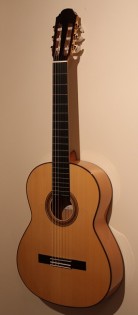
FG2B Model
2250€ outside EU (excl. 20% VAT)
Made entirely by hand under the technical direction of J. Castelluccia.
[badge bgcolor="#982b31" value="Disponible sur commande - Délai 2 à 3 mois"]

